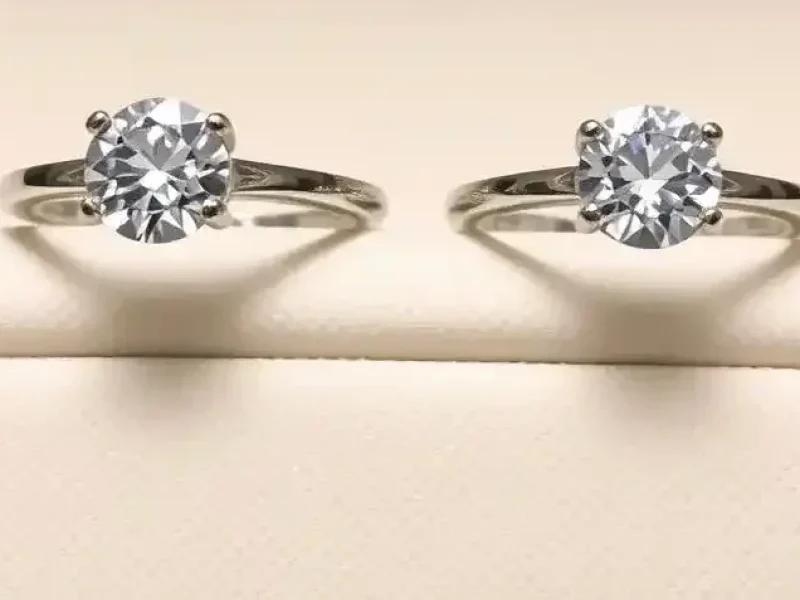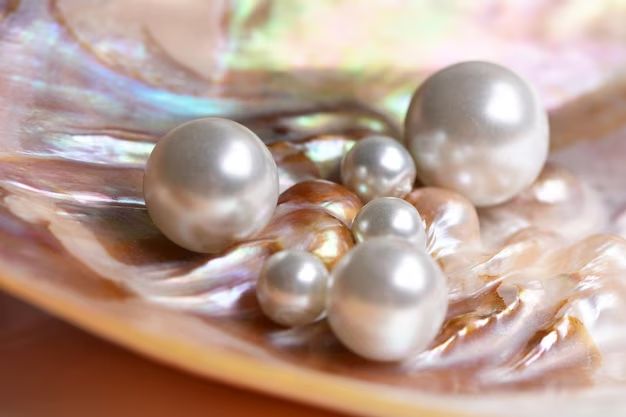
- Jewelry
Lab-Grown vs. Natural Diamonds: What Every Couple Needs to Know
Table of Contents
1. Introduction to Lab-Grown and Natural Diamonds
Diamonds have long been celebrated for their beauty and symbolic significance, representing love and commitment. Traditionally, natural diamonds—formed over billions of years deep within the Earth—have been the standard choice for engagement rings. However, the emergence of lab-grown diamonds—created through advanced technological processes—has introduced a new option for couples. Understanding the distinctions between these two types of diamonds is essential for making an informed choice.
2. The Formation Process
Natural Diamonds
Natural diamonds are created under extreme pressure and temperature conditions in the Earth's mantle. Carbon atoms bond in a crystalline structure over billions of years, resulting in diamonds with unique characteristics. The formation process is both rare and complex, contributing to the diamond's value and rarity.
Lab-Grown Diamonds
Lab-grown diamonds are produced using advanced technological methods that replicate the natural conditions of diamond formation. There are two primary methods for creating lab-grown diamonds:
• High Pressure High Temperature (HPHT): This method involves recreating the high-pressure and high-temperature environment found deep within the Earth. Carbon is subjected to these conditions to form diamonds that are chemically and physically identical to natural diamonds.
• Chemical Vapor Deposition (CVD): In this method, carbon-containing gases are introduced into a chamber, where they are ionized to form a plasma. The carbon atoms then deposit onto a substrate and crystallize into diamonds. CVD diamonds also share the same physical and chemical properties as natural diamonds.
3. Key Differences Between Lab-Grown and Natural Diamonds
Appearance
Both lab-grown and natural diamonds exhibit the same optical properties due to their identical crystal structures. They both possess brilliance, sparkle, and fire, making it challenging to differentiate between the two without specialized testing. However, subtle differences in inclusions and growth patterns can be detected by gemologists.
Durability
Diamonds are known for their exceptional hardness, rated at 10 on the Mohs scale. Both lab-grown and natural diamonds possess this hardness, ensuring they are equally durable and resistant to scratching and damage. Their longevity makes them ideal for everyday wear.
Value
Natural diamonds are typically more expensive due to their rarity and the costs associated with mining, cutting, and distributing them. The price of a natural diamond is influenced by factors such as its size, quality, and provenance.
Lab-grown diamonds are generally more affordable. The lower cost reflects the absence of mining expenses and the controlled production process. This allows buyers to choose larger or higher-quality diamonds within their budget.
Ethical and Environmental Considerations
Natural diamond mining has been associated with environmental and ethical concerns, including habitat destruction, water pollution, and human rights abuses. The trade of natural diamonds has also been linked to conflict financing in certain regions.
Lab-grown diamonds are often promoted as a more ethical and environmentally friendly alternative. They are created in controlled environments, reducing the negative impacts associated with mining. However, it is important to consider that the production of lab-grown diamonds still requires energy and resources, and their environmental impact can vary depending on the methods and energy sources used.
4. The 4Cs: Cut, Color, Clarity, and Carat
The 4Cs—cut, color, clarity, and carat—are essential criteria for evaluating diamonds. These factors apply to both lab-grown and natural diamonds and play a significant role in determining their quality and value.
Cut
The cut of a diamond affects its brilliance and sparkle. Both lab-grown and natural diamonds can be cut to high standards, and the quality of the cut can significantly impact the diamond's overall appearance.
Color
Diamonds are graded based on their color, ranging from D (colorless) to Z (yellow or brown). Lab-grown diamonds are available in a similar range of colors, and their color grades are comparable to those of natural diamonds.
Clarity
Clarity measures the presence of internal or external flaws, known as inclusions and blemishes. Natural diamonds often have inclusions due to the conditions of their formation. Lab-grown diamonds can also have inclusions, but they are typically less frequent and less noticeable, depending on the growth method used.
Carat
Carat refers to the weight of the diamond. Both lab-grown and natural diamonds can be found in a wide range of carat sizes, allowing for flexibility in choosing a diamond that fits your preferences and budget.
5. Common Questions and Answers
Q: How can we tell if a diamond is lab-grown or natural?
A: Distinguishing between lab-grown and natural diamonds requires specialized gemological equipment. Gemologists use tools such as spectrometers and microscopes to detect the growth patterns and inclusions that indicate the diamond’s origin. For non-specialists, it is virtually impossible to tell the difference between lab-grown and natural diamonds with the naked eye.
Q: Are lab-grown diamonds less valuable than natural diamonds?
A: Lab-grown diamonds are generally less expensive due to the absence of mining costs and the controlled production process. While lab-grown diamonds and natural diamonds may appear identical in terms of their physical characteristics and quality, they are fundamentally different. Natural diamonds are formed over millions of years under unique geological conditions, which imbues them with inherent rarity and historical significance. In contrast, lab-grown diamonds are created in controlled environments over a matter of weeks or months, making them less rare and carrying less historical value.
Due to these differences, the long-term value of lab-grown diamonds is likely to differ from that of natural diamonds. Natural diamonds typically hold their value well and may even appreciate over time due to their scarcity and the enduring appeal of their natural origins. Lab-grown diamonds, however, may face greater depreciation, as their production process is less rare and their supply can be adjusted more easily. Consequently, while lab-grown diamonds offer a more affordable alternative, their investment value and potential for long-term appreciation are generally lower compared to their natural counterparts."
Q: Do lab-grown diamonds have the same resale value as natural diamonds?
A: Lab-grown diamonds typically do not have the same resale value as natural diamonds. Natural diamonds often retain higher resale value due to their rarity, historical significance, and the extensive time required for their formation. In contrast, lab-grown diamonds may depreciate more quickly because they are produced at a lower cost and are perceived as less unique.
Additionally, some countries, such as India, are heavily investing in the production of lab-grown diamonds, which could increase their availability in the future. As the supply of lab-grown diamonds expands, their resale value may face more significant depreciation. On the other hand, the supply of natural diamonds remains relatively limited due to geological constraints. As demand continues to rise and supply grows slowly, natural diamonds are expected to appreciate in value over time, including in the resale market.
Q: Can lab-grown diamonds be passed down through generations like natural diamonds?
A: Lab-grown diamonds can certainly be passed down through generations, but their historical and emotional significance may differ from that of natural diamonds. Natural diamonds often carry a legacy of endurance and rarity, which adds to their sentimental value. Because natural diamonds are formed over millions of years and are relatively scarce, they tend to become more valuable over time as they are passed down through generations.
In contrast, lab-grown diamonds are produced with increasing frequency, which may affect their long-term value and perception of rarity. As their supply grows, they might not carry the same historical weight or appreciation over time. Therefore, while lab-grown diamonds can be cherished and passed down, they may not have the same legacy or increasing value associated with natural diamonds.
Q: How do we choose between a lab-grown and a natural diamond for our engagement ring?
A: The choice between a lab-grown and a natural diamond depends on your personal preferences, values, and budget. Consider factors such as ethical and environmental concerns, the significance of the diamond's origin, and the value you place on tradition versus modernity. While natural diamonds are not inherently unethical or environmentally harmful, it's important to weigh their impact and how it aligns with your values. Natural diamonds offer a modern alternative with a different set of benefits. Visiting a reputable jeweler like Artemies Gems and Jewelry can help you explore your options and find the perfect diamond for your engagement ring.
6. Making the Right Choice:
A Couple’s Journey
When couples like Sarah and Michael are in search of the perfect engagement ring, they often find themselves weighing the pros and cons of lab-grown versus natural diamonds. Sarah is drawn to the ethical and environmental benefits of lab-grown diamonds, while Michael values the tradition and rarity of natural diamonds.
Sarah and Michael decide to visit the Artemies Gems and Jewelry website to explore their options. They find a wealth of articles covering various aspects of diamonds, including formation processes, ethical considerations, and the 4Cs. The website provides comprehensive information about both natural and lab-grown diamonds, helping them understand their choices better. They can also view beautiful designs of natural diamonds with certificates and reach out to the customer service team via email for any additional questions. This allows Sarah and Michael to make a well-informed decision based on their preferences and needs.
After considering their values and preferences, Sarah and Michael choose a natural diamond for their engagement ring. They appreciate the unique qualities and historical significance of the natural diamond and feel that it best represents their love and commitment.
7. Conclusion
Choosing between a lab-grown and a natural diamond is a personal decision that involves evaluating various factors, including appearance, durability, ethical considerations, and value. Both types of diamonds have their own unique qualities, and understanding these differences can help couples make an informed choice that aligns with their preferences and beliefs.
At Artemies Gems and Jewelry, we are committed to helping you find the perfect diamond that represents your love story. While lab-grown diamonds offer a modern and ethical alternative, we specialize in offering natural diamond jewelry. Natural diamonds, with their rich history and rarity, embody the timeless beauty and significance that many couples seek.
For couples who value the tradition and uniqueness of natural diamonds, Artemies Gems and Jewelry provides a curated selection of exquisite natural diamond jewelry. Our experienced jewelers are here to guide you through the process and help you find a diamond that reflects your unique love and commitment.
Visit Artemies Gems and Jewelry website to explore our collection and discover the natural diamond that perfectly represents your love story. Let us help you find a piece that will be cherished for generations to come.
Related Posts
Fall in Love with Jewelry, Stories, and Secrets
Join Artemies Magazine for insider jewelry tips, trend updates, and subscriber-only discounts.



